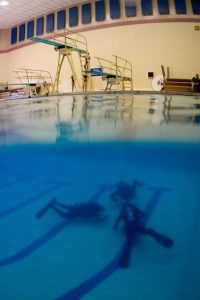 Course Outcomes
Course Outcomes
The GUE Recreational Diver Level 1 course is designed to develop the essential skills required for all sound diving practice. It helps the non-diver cultivate a platform that supports comfort, confidence, and competence in the water, as well as more advanced training in the future.
Prerequisites
Applicants for a Rec 1 course must:
- Submit a completed registration form, a medical history, and a liability release to GUE Headquarters.
- Be physically and mentally fit.
- Hold insurance that will cover diving emergencies such as hyperbaric treatment, e.g. DAN Master-level insurance or equivalent.
- Be a nonsmoker.
- Obtain a physician’s prior written authorization for the use of prescription drugs, except for birth control, or for any prior medical condition that may pose a risk while diving.
- Be a minimum of 16 years of age.
Course Content
The Recreational Diver Level 1 course is conducted over a minimum of five days, and includes fourteen dives and at least forty hours of instruction, encompassing classroom, land drills, and in-water work.
Rec 1 Specific Training Standards
- Student-to-instructor ratio is not to exceed 8:1 during land drill or surface exercises; it is not to exceed 4:1 during any in-water training.
- Can be run with one trainee.
- Maximum depth 70 feet/21 meters.
- No planned decompression.
- No overhead diving.
- No night diving.
Required Training Materials
GUE training materials and recommended reading as determined by the course study packet received via online download after GUE course registration.
Academic Topics
- Introduction to Scuba Diving
- Building a Solid Foundation
- Exploring the Underwater World
- Gas Management and Dive Planning
- Decompression Dynamics
- Diving Safety the GUE system
Land Drills & Topics
- Equipment fit and function
- Dive team protocols
- Analyze and mark cylinders
- Pre-dive drills
- Basic 5 scuba skills
- S-drill
- Propulsion techniques
- Surface-marker buoydeployment
- Straight line compass navigation
Required Dive Skills & Drills
- Must be able to swim at least 300 yards/275 meters in under fourteen minutes without stopping. This test should be conducted in a swimsuit and, where necessary, appropriate thermal protection.
- Must be able to swim a distance of at least 50 feet/15 meters on a breath hold while submerged.
- Demonstrate proficiency in safe diving techniques, including pre-dive preparations, in-water activity, and post-dive assessments.
- Demonstrate awareness of team member location and a concern for safety, responding quickly to visual indications and dive partner needs.
- Efficiently and comfortably demonstrate how to donate gas to an out-of-gas diver followed by an ascent to the surface, utilizing minimum decompression.
- Comfortably demonstrate at least two propulsion techniques that would be appropriate in delicate and/or silty environments; students should demonstrate comprehension of the components necessary for a successful backward kick.
- Demonstrate a safe and responsible demeanor throughout all training.
- Demonstrate reasonable proficiency in the ability to deploy a surface marker buoy while utilizing a spool.
- Demonstrate good buoyancy and trim, i.e. approximate reference is a maximum of 30 degrees off horizontal while remaining within 5 feet/1.5 meters of a target depth.
- Demonstrate proficiency in underwater communication.
- Demonstrate basic equipment proficiency and an understanding of the GUE equipment configuration.
- Demonstrate aptitude in the following open-water skills: mask clearing, mask removal and replacement, regulator removal and exchange, long hose deployment.
- Demonstrate safe ascent and descent procedures.
- Demonstrate proficiency in the basic 5 rescue techniques.
Equipment Requirements
GUE base configuration as outlined in Appendix A.
Note: Prior to the commencement of class, students should consult with a GUE representative to verify equipment requirements. Whether or not a piece of equipment fulfills GUE’s equipment requirement remains at the discretion of GUE and its instructor representatives. Participants are responsible for providing all equipment or for making provisions to secure the use of necessary equipment before the start of the course. In general, it is better for the student to learn while using his or her own equipment. However, students should exercise caution before purchasing new equipment to avoid acquiring substandard equipment. Please contact a GUE representative prior to making any purchases. Information about recommended equipment can be obtained from the equipment considerations section of GUE’s Web site.
